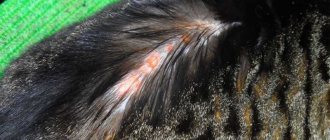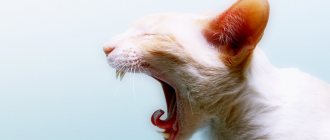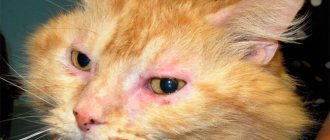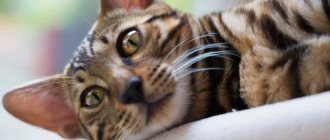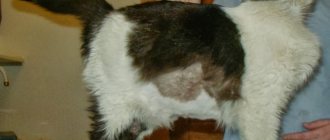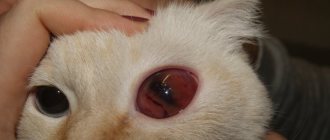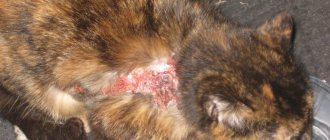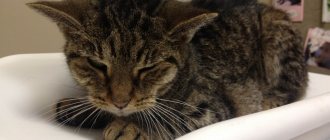If a small kitten staggers while walking and falls, this always alarms the owner. The situation seems especially strange when the pet does not have any other health problems. The kitten has a good appetite, it is mobile and active, and does not emit a plaintive meow. But he is not able to walk normally, as a rule, from his very first steps. This may be a manifestation of cerebellar ataxia in cats. This pathology does not affect the general health in any way. Poor coordination of movements is its only manifestation.
Why does the kitten walk poorly?
Cerebellar ataxia in cats is a congenital pathology. It manifests itself at an early age, when kittens begin to take their first independent steps.
Ataxia is a disorder of motor coordination. This deviation can have various origins. In this case, the cause of the pathology is underdevelopment of the cerebellum. This organ is responsible for the sensation of the body’s position in space and the coherence of movements.
In sick kittens, damage to the cerebellum occurs during fetal development due to various adverse effects on the mother’s body during pregnancy. Various factors can contribute to the birth of a sick kitten. Most often, cerebellar ataxia in babies occurs if a pregnant cat has had panleukopenia (distemper). Parvovirus causes damage to the cerebellum, which leads to hypoplasia of the organ.
Ataxia in kittens usually develops if the mother becomes ill with distemper in the later stages. Infection with panleukopenia early in pregnancy usually leads to the death of the embryos. If the infection occurs closer to birth, then both dead kittens and cubs with cerebellar hypoplasia may be born.
Other harmful effects on the mother’s body can also lead to congenital ataxia in a kitten:
- bacterial infectious diseases;
- food or poison poisoning;
- helminthic infestation;
- poor nutrition.
There is also a hereditary form of ataxia in cats. However, this pathology is rare.
Consequences of stress
A dilated pupil in a cat can cause deep distress. This phenomenon can be especially often noticed in cats that have just moved into a new apartment, have not yet explored the situation and are expecting an attack from literally around every corner.
An animal’s worries can be caused by the appearance of a new pet in the house: a puppy, a cat, or someone else. The pussy will be under stress for a long time, fighting for its territory and the attention of its owners.
The real horror for most cats, especially young ones, is the process of bathing. After this, many cats cannot calm down for a long time. Hence the “big” eyes.
Surely every owner has seen the huge eyes of their cat the moment they turn on the vacuum cleaner, blender or other household appliances. The cat does not understand the design of the unit and is trying to figure out where the sound is coming from, why it is dangerous and why it is so loud and sudden. Over time, many purrs get used to extraneous sounds and react less fearfully.
Signs of pathology
The disease first appears in childhood, when the kitten begins to move actively. The baby walks with a strong stagger (“drunk gait”), often falls and spreads his paws wide when moving. This is the leading symptom of the pathology. In addition, the kitten's head trembles, especially when it tries to focus its attention on a toy or some other object.
Veterinarians distinguish several degrees of cerebellar ataxia in cats:
- Easy. The kitten has slight gait disturbances, and the baby periodically falls. But in general, the animal moves without any problems.
- Average. The pet's movement is very difficult, and frequent falls are observed. But the animal is still able to walk.
- Heavy. The animal cannot move at all.
However, the pets do not experience any other changes in their health status. This disease is not accompanied by pain. Cats with ataxia eat normally and do not feel ill.
A kitten with ataxia develops normally. Damage to the cerebellum does not affect the mental abilities of the pet in any way. The disease also does not affect life expectancy. A cat with ataxia can live to a ripe old age.
This disease does not progress. On the contrary, with age, the animal’s movements become more coordinated. If a cat’s gait worsens over time, then most likely this is due to other pathologies, and not to cerebellar ataxia.
Impaired balance (coordination of movements) in dogs and cats.
- home
- Articles
- Publications of specialists
- Veterinary
- Impaired balance (coordination of movements) in dogs and cats.
A sudden loss of coordination of movements is explained by a disease of the balance organs and is called “vestibular syndrome of dogs (or cats).” The symptoms can look frightening: an apparently healthy animal suddenly cannot rise to its feet, falls, flounders, and looks frightened. There may also be drooling, vomiting, and rapid breathing. The head is tilted to the side, the muzzle is asymmetrical. The first thing that comes to mind in such cases is that the animal is having a stroke. But stroke is perhaps the rarest cause of these symptoms. Most often, such manifestations are caused by disruption of the balance organs located outside the brain - the so-called peripheral vestibular syndrome
.
The causes of peripheral vestibular syndrome are as follows: - Inflammation of the middle and inner ear (otitis media) is the most common cause of peripheral vestibular syndrome. The organ of balance - the labyrinth of the cochlea - is inextricably linked with the organ of hearing. Inflammation during otitis media can spread to the cochlear labyrinth and cause disruption of its functioning. In this case, treatment should include antibiotics and anti-inflammatory drugs. Dealing with this disease can take a lot of time and effort. Symptoms of vestibular disorder disappear within 10-14 days. When treating otitis media, the use of ototoxic drugs such as chlorhexidine and aminoglycoside antibiotics should be avoided. — Neoplasms (tumors, polyps, cysts) of the inner ear, eustachian tube, eardrum. To diagnose these formations, conventional examination and otoscopy are not enough, but additional visual diagnostic methods and cytological analysis are required. The most effective method of treating tumors is surgery. — Idiopathic vestibular syndrome is the second most common cause of balance problems. In cats, this disease occurs most often during the summer months. Cats of all ages are affected. Dogs get sick more often at older ages and regardless of the time of year. 72 hours after the onset of symptoms, a significant improvement occurs - nystagmus (rhythmic movements of the eyeballs) and nausea almost disappear, appetite and the ability to walk appear. After 7 days the animal can move normally. The head tilt can persist for a longer time - up to 2 months. No specific treatment has been developed. Recovery occurs without treatment, but recurrence of the disease is possible. — The use of ototoxic drugs (aminoglycoside antibiotics, chlorhexidine, metronidazole) — Congenital abnormalities of the organ of hearing and balance have been described in such breeds as: German Shepherd, Doberman, English Cocker Spaniel, Beagle, Siamese, Burmese cat and some others. Congenital disorders appear from birth or at 3-4 weeks of age. Some animals live with this disorder their entire lives. In some cases, spontaneous recovery occurs by 3-4 months of age. No treatment has been developed. — Temporal bone injury. Let us remember that above we discussed diseases that do not affect the brain. This is the most common cause of sudden loss of coordination in pets. Less commonly, vestibular disorders are the result of diseases affecting the brain
.
Symptoms of imbalance that occur when these structures are affected are called central vestibular syndrome
. The causes of central vestibular disorders are the following diseases: - Infectious diseases of the brain: canine distemper, feline infectious peritonitis (FIP), toxoplasmosis, cryptococcosis. — Inflammatory diseases of the nervous system: granulomatous meningoencephalomyelitis, necrotizing meningoencephalomyelitis. — Brain tumors – meningiomas, lymphomas. — Vascular diseases of the brain: ischemic, hemorrhagic stroke as a result of hypertension, hormonal disorders, sepsis, bleeding disorders, thrombosis of cerebral vessels. The prognosis for these diseases is more cautious than for peripheral disorders. As a rule, in addition to symptoms of imbalance, the animal also exhibits other neurological disorders, as well as symptoms of damage to other organs and systems. Symptoms of peripheral and central vestibular syndrome are listed in the table:
In each case of impaired coordination of movements, doctors need the most complete information about the animal. Therefore, when faced with cases of imbalance in animals, specialists conduct a particularly thorough examination. Depending on what disease the symptoms and course of vestibular disorders indicate, a diagnostic and treatment plan is drawn up. In some cases, diagnosis may be limited to a routine examination of the animal, examination of the ears, general and clinical blood tests, and this will be sufficient to establish a diagnosis and prescribe treatment. In more complex cases, advanced diagnostics may be needed - tests for viral and bacterial infections, tests for thyroid and adrenal hormones, x-rays, ultrasound of internal organs, computed tomography of the brain, cerebrospinal fluid analysis.
05 February 2009
178346
Health to you and your pets!
© 2020 Team "ZOOVET" We are always happy to help you! 24-hour consultation: +7 Make an appointment [email protected]
Return to list
Characteristics of sick cats
Sometimes on the Internet you can find advertisements for the placement of kittens with cerebellar ataxia into good hands. And many owners willingly accept such animals into their homes. Why do people try to buy a sick kitten?
Previously, such cubs were most often euthanized. After all, treatment for cerebellar ataxia in cats has not yet been developed. However, these days, these animals are increasingly finding loving owners.
Cats with ataxia are unaware of their illness. They do not experience any unpleasant sensations. These animals just need extra attention and care. With the help of the owner, sick cats can lead a normal life, especially with mild to moderate pathology.
Cats with congenital cerebellar hypoplasia are distinguished by their kindness and increased affection. They become strongly attached to their owner, as they largely depend on human help. The popularity of these animals is due to their kind and friendly nature.
In the video below you can see two kittens with cerebellar ataxia playing. The disease does not prevent them from being mobile and active.
General group of symptoms for all types
The disease has species-typical and generally similar symptoms. The different symptoms depend on the causes. All types of pathology are characterized by:
- the cat holds its head atypically, it can tilt it to the side or lower it down;
- a staggering gait is observed, the animal loses coordination, the cat can walk, raising its hind legs high.
Epilepsy in cats: symptoms, treatment, how to stop seizures
If the animal's spinal cord is damaged, it will experience pain when walking. Such cats try to hide in a quiet place and move less.
Attention! In severe forms, paralysis of the hind limbs can develop in cats.
With cerebellar ataxia, tremor occurs when running or walking. The kitten will often tremble, and most often the trembling is noticeable only in the back of the body. The cat also has dilated pupils and poor coordination.
If the vestibular apparatus is affected, the cat will suffer from severe headaches. Such animals constantly meow, hide in the corner, pressing their foreheads against the wall.
Hind limb paralysis
Diagnostics
An experienced veterinarian can detect the disease during examination of the kitten. A characteristic sign of this pathology is the onset of problems with coordination of movements at an early age.
However, ataxia can also have other origins. This symptom can occur with injuries, infections and tumors. Therefore, the veterinarian takes a history and may ask the owner the following questions:
- Has the kitten ever fallen or been injured?
- Did the cat have any poisoning?
- What infections did the cub have?
- Are there any other health problems other than poor motor coordination?
An MRI examination will help make an accurate diagnosis of a kitten. Using this diagnosis, it is possible to establish underdevelopment of the cerebellum.
Problems are hidden in the depths
If a cat's pupils are constantly dilated, this may indicate the presence of a disease not related to vision at all. Large round eyes can be evidence of the pain that the animal constantly experiences. Many pussies are real stoics: they meekly endure the pain of injuries, endure convulsions and spasms.
If the unhappy expression on the face and large round pupils are accompanied by constant lethargy of the animal, unnatural postures during sleep, refusal to eat, stiff gait or inactivity, the owners should sound the alarm. The cause could be anywhere: dislocation, infection, heart disease, stroke, internal bleeding and much more. Only an experienced doctor, having carried out all the necessary tests, will be able to tell exactly what is hurting your pet.
Treatment
How to treat ataxia in cats? If the pathology is associated with congenital underdevelopment of the cerebellum, then currently no effective treatment methods have been developed. A sick kitten will never be able to move as confidently as healthy animals. However, most owners find it very difficult to come to terms with this situation. How to help the baby?
Treatment of ataxia in cats at home can only consist of developing movements through games. This will be a kind of physical therapy for your pet.
Treatment on an outpatient basis and at home
It is important that therapy is carried out comprehensively. The treatment regimen is developed depending on the cause that caused the development of the disease. In this regard, the dosage of drugs may differ even if we are talking about the same form of pathology.
The following medications are most often prescribed:
- vitamin complexes, B vitamins;
- to eliminate infections - antibiotics;
- for swelling of the brain - diuretics;
- Hepatoject for liver dysfunction;
- to improve blood circulation in the brain - Cerebrolysate;
- saline solutions in droppers to relieve intoxication.
Physiotherapy and massage are recommended for the animal. If the spinal cord is affected, surgery is required.
Important! You should not try to treat yourself. A sick animal requires professional advice from a veterinarian. The severe form cannot be eliminated using folk methods alone without an integrated approach.
Vitamins for full recovery
How to play with a kitten
To develop coordination of movements, it is useful to arrange games with “prey” in the form of a toy mouse or other object suspended on a fishing rod with a string. It needs to be moved along the floor or slightly raised above the surface. There is no need to force your pet to reach for a toy; such a kitten does not stand well on its hind legs. Also, do not force your pet to jump, otherwise it may end in a fall.
But throwing movements work well for kittens with ataxia. The animal may ambush the toy. In this case, the kitten usually turns over on its back and grabs the prey with its paws. Developing such movements in a cat is very useful.
We must not forget about games for the development of fine motor skills. Nowadays, there are special puzzles for cats on sale with balls and toys hidden inside, as well as mazes. Such toys are very useful for animals with ataxia, as they help develop the accuracy of small movements.
All educational games must be supervised by the owner. After all, cats with ataxia fall very often.
Storm in a bowl of milk
In a calm state, cat eyes are of normal size, and the pupils are more like narrow slits. A cat's dilated pupil appears during evening runs along the ceiling and walls. During this period, the angry animal receives a powerful surge of adrenaline, and its eyes turn into huge “tea saucers.” At this moment, pupil enlargement also has a purely practical function. By performing masterly jumps and somersaults, the cat orients itself better in space and sees the outlines of objects more clearly. The dilated pupils at this moment help her not to hurt herself or get hurt.
You can also notice a dilated pupil in a cat when she is hunting. The pet concentrates its attention and hopes that a mouse is about to appear around the corner.
It is absolutely clear that such manifestations do not require treatment at all. The owners can rest easy. When the storm in a glass of water subsides and the tension subsides, the cat's pupils will return to normal size.
How to make your home safe for your pet
Since there is no effective treatment for cerebellar ataxia, it is very important to protect your pet as much as possible from injury from falls. After all, a lack of coordination will accompany the animal throughout its life. To prevent the kitten from getting hurt, you must follow the following rules:
- It is very important that the floor is not slippery, otherwise the animal’s paws will move apart greatly. Wood flooring should be smooth to prevent your pet from getting a splinter. The ideal surface is carpet. It will be convenient for the cat to move around. You can also cover the floor with rugs.
- It is necessary to remove from the floor all large unnecessary objects that the cat might stumble upon while moving.
- Many cats love to climb on bedspreads and curtains. Such vertical surfaces must be securely fastened. You need to pay attention to the length of your pet’s claws. After all, with their help the animal clings to the fabric. You cannot cut the nails too short, otherwise the pet will not be able to hold on to them. At the same time, the claws should not be allowed to curl and get stuck in the fabric.
- Feeding cats with ataxia should be supervised by the owner. An animal with a movement disorder often splashes water and scatters food. Therefore, bowls should be placed so that the feeding area is easy to clean. After eating, you need to wipe the animal's paws and face.
It is important to remember that with ataxia, independent walks are strictly contraindicated for cats. Such animals can get hit by a car; they cannot defend themselves from aggressive relatives and cannot escape from dogs. However, pets with ataxia usually enjoy movement. They can be walked, but only on a harness.
Sensitive ataxia (proprioceptive)
The consequence of damage to either the posterior columns of the spinal cord, or its roots, or peripheral nerves.
Similarly, there are pathologies of the parietal lobe cortex and thalamus opticus. Tumors and diseases of the intervertebral discs in cats also affect the development of sensitive ataxia.
The main problem is that the animal is not able to bend and straighten its limbs at the joints. The ability to consciously determine the direction of movement is lost.
There is pain in the neck and back area, movements are also painful, and the cat tries to move as little as possible. In severe cases, any movement is simply impossible.
If the brain is damaged in a small part, and treatment was prescribed as quickly as possible at an early stage, there is a chance that the animal will return to normal healthy life.
Veterinarian advice on prevention
How to prevent cerebellar ataxia in cats? It is necessary to protect a pregnant pet from any harmful influences. You need to adhere to the following recommendations from experts on keeping a cat in an “interesting situation”:
- You should not let your pet go for walks.
- When arriving home, the owner must immediately change his shoes and wash his hands thoroughly. People often carry the distemper virus on the soles of their shoes.
- It is necessary to exclude contact of the cat with infected animals.
- Before mating, it is necessary to take a parvovirus test and deworm the animal.
- A pregnant cat needs adequate nutrition.
- It is necessary to monitor the quality of food and protect the animal from poisoning.
Following these rules will significantly reduce the risk of giving birth to a kitten with ataxia.
My clear light
The eyes of a cat, like any living creature, react to light. In bright light they narrow, and in dim light they expand. If a cat has constantly dilated pupils, the owners need to start worrying. Your pet may have decreased visual acuity. A veterinarian will help determine the cause. With eye diseases, the pupil's sensitivity to light gradually decreases, so even in very bright light, a cat's pupils may remain dilated.
It makes sense to listen to the feedback of specialists and experienced animal owners. Delay may result in your pet becoming completely blind. Even without a doctor, you can determine which eye is affected by the disease. The damaged pupil will remain dilated at all times, regardless of changes in the lighting situation.
Symptomatic diet and procedures
It is worth remembering that a cat will not just shake its head for a long time or scratch the ear area until it gets abrased. Most often, the cause of tremor, fortunately, is not associated with serious disorders, and recovery occurs quickly.
But many diseases, in particular the appearance of ear mites, fleas, injuries, foreign bodies and water getting into the ears, can be prevented. It is enough to monitor the cleanliness of your pet’s body in general and the ears in particular. At the first signs of parasites, it is important to treat the ears with medications as quickly as possible.
If the cat is domestic, you should not let it go outside alone. And after “rolling on the ground,” the cat’s ears need to be carefully cleaned. Do not use a cotton swab on your ears. For cleaning, use soft cotton swabs rolled into tubes. The tampon must be damp. Before treating your ears, you can dip it in boiled water or saline solution.
You need to wash your cat correctly. Avoid getting water in your ears. Therefore, it is better to water your head not with a powerful jet from the shower, but with the help of a ladle, slowly and carefully. You need to pour water from above and back. Don't forget to give your cat a chance to shake itself off after water treatments.
To prevent tremors from appearing due to serious health problems, you need to balance your pet’s daily diet, periodically carry out health improvement with the help of vitamin and mineral complexes, and take your cat to the veterinarian at least once a year.
Idiopathic feline vestibular syndrome: what is it?
It is easy for the owner to imagine what the essence of the disease is if he has ever ridden on a carousel. To feel normal and enjoy skating you need to have a strong vestibular system. The ability to easily move in space, run, catch mice (birds) and sneak up on prey unnoticed is due to good coordination of the primary sensory system. It is precisely this that is needed to maintain balance and normal orientation of the body with the Earth’s gravitational field. When fine adjustments are violated, idiopathic vestibular syndrome develops.
Important! In the veterinary literature you can find other names for the disease: feline vestibular syndrome, idiopathic vestibular disease, idiopathic vestibular neuropathy.
When to see a doctor
If a cat's tremor is accompanied by fever, indigestion or pain, the animal must be urgently taken to the clinic or a veterinarian called to your home.
Also, a cat whose trembling turns into convulsions or epileptic attacks requires immediate hospitalization.
Sometimes the owner cannot understand why a kitten or an adult cat is shaking violently, and at the same time she arches her back, meows quietly, and tries to burp. Such signs usually indicate ingestion of a foreign object that is causing pain or discomfort. In this case, the animal can only be saved in a clinical setting if the object is surgically removed in a timely manner.
What signs indicate feline idiopathic vestibular syndrome?
The most important symptom is sudden disorientation in space. Just a day ago, the cat felt great, but now she is experiencing ataxia, abnormal vocalization (seemingly for no reason), reluctance to leave the surface and fear of rising above the floor (ground). The owner’s bewilderment is understandable - the animal has no visible injuries, and an exact cause-and-effect relationship cannot be identified, even after undergoing a full diagnostic examination at a veterinary clinic.
The symptoms are:
- tilting the head towards the affected side;
- if the pathology is bilateral, the cat sits and shakes its head (“Chinese dummy”) with a large amplitude of tilt;
- nystagmus at rest (but may be absent with bilateral lesions);
- vestibular ataxia with a tendency to twist and fall.
Extensive damage (bilateral) can be diagnosed by the cat’s behavior - it does not want to move, remains in place, has a hunched posture or paws widely spaced.
Causes
Prerequisites can be inherited or acquired. Congenital predisposition is characteristic of cerebellar ataxia. Pathological signs appear by six months of age. However, the cerebellar variety can also be acquired.
The most likely causes of uncoordinated movements include the following:
- viral infections: with panleukopenia, kittens predisposed to ataxia are born in mature females;
- back or skull injuries;
- otitis of parasitic, allergic or infectious origin;
- poisoning
Causes of ataxia in cats
There are several reasons why you can directly encounter ataxia. Some can be prevented, the likelihood of others depends little on us, but we need to know about them at least in order to quickly respond if necessary:
- genetic inheritance;
- infectious diseases causing pathologies of the central nervous system and brain;
- cerebral edema;
- traumatic brain injuries;
- severe poisoning with toxins, household chemicals;
- hunger or systematic malnutrition;
- acute deficiency of B vitamins and folic acid.



